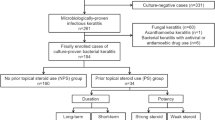Abstract
Background: Fifty-four consecutive cases of culture-positive bacterial ulcerative keratitis presenting at a major university hospital were reviewed to identify factors predictive of response to medical therapy for bacterial ulcerative keratitis (BUK). • Methods: Eleven patients (20%) failed medical therapy (defined as the need for surgical intervention or cyanoacrylate gluing). Using multivariate logistic regression, the following variables were evaluated: (1) predisposing ocular factors (e.g., contact lens wear), (2) pre-existing ocular diseases, (3) ulcer size, and (4) the number of topical ocular medications used at the time of presentation. • Results: We noted certain factors to be potentially predictive of medical therapy outcome. The average size of the ulcer at the time of presentation was 4.4±2.4 mm in the failure group but only 2.5±1.9 mm for the success group (P=0.027). In addition, patients in the medical failure group used more topical ocular medications at the time of presentation (P=0.0075). Further analysis of the individual topical ocular medications revealed that the use of corticosteroids was higher in the failure group (56% vs 12%, P=0.0005 by Fisher's exact test). Other factors such as patient age, the type of organism(s), and the time elapsed between the onset of symptoms and the beginning of definitive therapy were not statistically significant. • Conclusion: In this population, ulcer size at the onset of antibacterial treatment and the use of certain ocular medications, specifically corticosteroids, were significant predictive factors for failure of medical therapy for BUK.
Similar content being viewed by others
References
Adams CP Jr, Cohen EJ, Laibson PR, et al. (1983) Corneal ulcers in patients with cosmetic extended wear contact lenses. Am J Ophthalmol 86: 705–709
Alfonso E, Mendelbaum S, Fox MJ, Forster RK (1986) Ulcerative keratitis associated with contact lens wear. Am J Ophthalmol 101: 429–433
Alfonso E, Kenyon KR, Ormerod LD, et al. (1987) Pseudomonas corneoscleritis. Am J Ophthalmol 103: 90–98
Asbell P, Stenson S (1982) Ulcerative keratitis — survey of 30 years' laboratory experience. Arch Ophthalmol 100: 77–80
Chalupa E, Swarbrick HA, Holden BA, Sjostrand J (1987) Severe corneal infections associated with contact lens wear. Ophthalmology 104: 17–22
Cohen EJ, Laibson PR, Arentsen JJ, Clemons CS (1987) Corneal ulcers associated with cosmetic extended wear soft contact lenses. Ophthalmology 94: 109–114
Coster DJ, Badenoch PR (1987) Host, microbial, and pharmacological factors affecting the outcome of suppurative keratitis. Br J Ophthalmol 71: 96–101
Dart JKG (1988) Predictive factors in microbial keratitis: significance of contact lens wear. Br J Ophthalmol 72: 926–930
Dart JKD, Stapleton F, Minassian D (1991) Contact lenses and other risk factors in microbial keratitis. Lancet 338: 650–653
Donnenfeld ED, Cohen EJ, Arentsen JJ, et al. (1986) Changing trends in contact lens associated corneal ulcers: an overview of 116 cases. CLAO J 12: 145–149
Galentine PG, Cohen EJ, Laibson PR, et al. (1984) Corneal ulcers associated with contact lens wear. Arch Ophthalmol 102: 891–894
Groden LR, Brinsner JH (1986) Outpatient treatment of microbial corneal ulcers. Arch Ophthalmol 104: 84–86
Gudmundsson OG, Ormerod LD, Kenyon KR, et al. (1989) Factors influencing predilection and outcome in bacterial keratitis. Cornea 8: 115–121
Harte VJ, O'Hanrahan MT, Timoney RF (1978) Microbial contamination in residues of ophthalmic preparations. Int J Pharm 1: 165–171
Hjortdal JO, Ehles N (1989) Exogenous, ocular, and systemic factors associated with keratitic ulceration. Acta Ophthalmol 67: 169–173
Koidu-Tsiligianni A, Alfonzo E, Forster RK (1989) Ulcerative keratitis associated with contact lens wear. Am J Ophthalmol 108: 64–67
Liesgang TJ, Forster RK (1980) Spectrum of microbial keratitis in South Florida. Am J Ophthalmol 90: 38–47
Mahajan VM (1985) Ulcerative keratitis: an analysis of laboratory data in 674 cases. J Ocult Ther Surg 84: 138–141
Mondino BJ, Weissman BA, Farb MD, Pettit TH (1986) Corneal ulcers associated with daily-wear and extended-wear soft contact lenses. Am J Ophthalmol 102: 58–65
Musch DC, Sugar A, Meyer RF (1983) Demographic and predisposing factors in corneal ulceration. Arch Opthalmol 101: 1545–1548
Ormerod DL, Smith RE (1986) Contact lens-associated microbial keratitis. Arch Ophthalmol 104: 79–83
Ormerod DL, Hertzmark A, Gomez DS, et al. (1987) Epidemiology of microbial keratitis in Southern California. Ophthalmology 94: 1322–1333
Patrinely JR, Wilhelmus KR, Rubin JM, et al. (1985) Bacterial keratitis associated with extended wear soft contact lenses. CLAO J 11: 234–236
Schein OD, Wasson PJ, Boruchoff SA, Kenyon KR (1988) Microbial keratitis associated with contaminated ocular medications. Am J Ophthalmol 105: 361–365
Schein OD, Glynn RJ, Poggio EC, et al. (1989) The relative risk of ulcerative keratitis among users of daily-wear and extended-wear soft contact lenses. N Engl J Med 321: 773–778
Schein OD, Hibberd PL, Starck T, et al. (1992) Microbial contamination of in use ocular medications. Arch Ophthalmol 110: 82–85
Stern GA (1991) Corneal infections in contact lens wearers. Int Ophthalmol Clin 31: 147–161
Weissman BA, Mondino BJ, Pettit TH, Hofbauer JD (1984) Corneal ulcers associated with extended wear soft contact lenses. Am J Ophthalmol 97: 476–481
Wilhelmus KR (1987) Review of clinical experience with microbial keratitis associated with contact lenses. CLAO J 13: 211–214
Author information
Authors and Affiliations
Rights and permissions
About this article
Cite this article
Kim, R.Y., Cooper, K.L. & Kelly, L.D. Predictive factors for response to medical therapy in bacterial ulcerative keratitis. Graefe's Arch Clin Exp Ophthalmol 234, 731–738 (1996). https://doi.org/10.1007/BF00189353
Received:
Revised:
Accepted:
Issue Date:
DOI: https://doi.org/10.1007/BF00189353




